The Economics and Statistics Division maintains archives of previous publications for accountability purposes, but makes no updates to keep these documents current with the latest data revisions from Statistics Canada. As a result, information in older documents may not be accurate. Please exercise caution when referring to older documents. For the latest information and historical data, please contact the individual listed to the right.
<--- Return to Archive
For additional information relating to this article, please contact:
June 22, 2022NOVA SCOTIA QUARTERLY POPULATION ESTIMATES AS OF APRIL 1, 2022 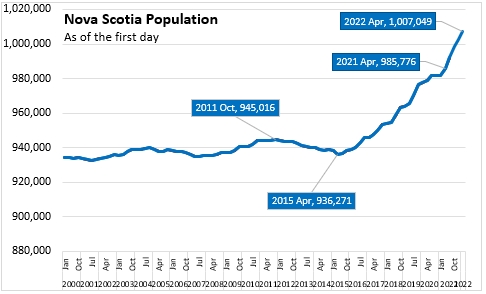
Nova Scotia's population was 1,007,049 as of April 1, 2022. This continues Nova Scotia's accelerated population growth - rising by 4,436 (+0.45%) from January 1, 2022. This is the largest population increase for the January 1 - March 31 period in quarterly data going back to 1971.
Compared with April 1, 2022, Nova Scotia's population increased by 21,273 (+2.16%). This was also the largest 12-month population increase in the quarterly population data starting in 1971.
Since ending a period of population decline on April 1, 2015 Nova Scotia's population has increased by 70,778.
Nova Scotia's population growth reflected a continuation of elevated immigration and interprovincial in-migration along with low interprovincial out-migration. Natural population change (births, less deaths) continues to draw Nova Scotia's population down.
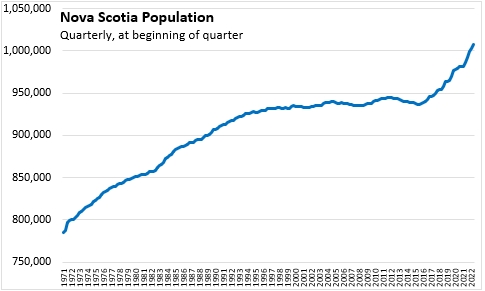

There are seasonal patterns in quarterly population changes, particularly evident in births and migration. From January 1 to March 31 2022, Nova Scotia posted a population increase that is atypically large for the quarter.
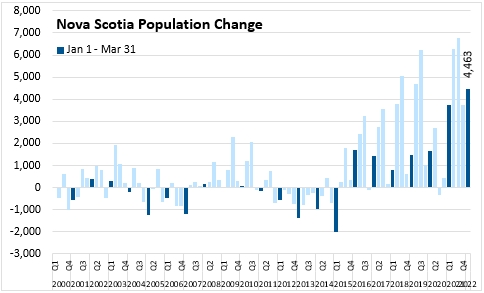
From January 1, 2022 to April 1, 2022 Nova Scotia’s population increased 0.45% (+4,463), while the national population grew 0.33%. Nova Scotia had the third fastest population growth in the quarter among the provinces after Prince Edward Island and Alberta.
Compared with April 1, 2021 Nova Scotia’s population increased 2.16% (+21,273), while the national population grew by 1.31%. Nova Scotia's population growth over this period was the second fastest among provinces. Prince Edward Island (+3.13%) had the fastest growth over past year while the slowest was in Saskatchewan (+0.51%).
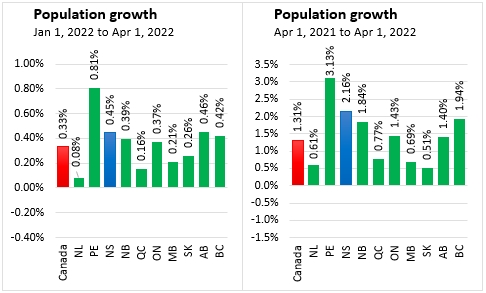
Immigration from other countries has been a strong contributor to population growth in Nova Scotia in recent years. While immigration slowed during periods of border restrictions over the course of the COVID-19 pandemic, there was a strong resurgence of immigration since July 1, 2021. Immigration to the province was 3,204 in the period from January 1 to March 31. Although this below the high set in the previous quarter, it is the strongest immigration in the January 1 - March 31 period in quarterly data going back to 1946. The 11,245 immigrants to Nova Scotia since April 1, 2021 were the largest 12 month immigration in the post-1946 records.

The net change in nonpermanent residents in the province was an inflow of 97 from January 1 to March 31. This was a slower increase from net non-permanent residents than was observed from January 1 - March 31. Over the last 12 months (April 1, 2021 to March 31, 2022), there has been a net increase of 1,536 non-permanent residents.
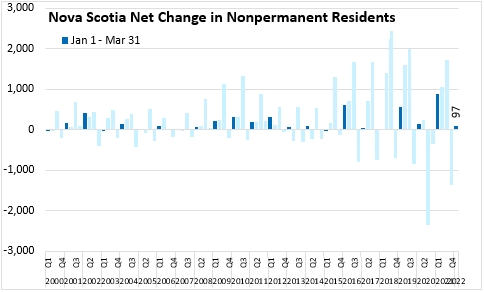
Nova Scotia’s natural population change (the number of births less the number of deaths) has been negative for several years. Between January 1 and March 31 there were 1,939 births and 3,026 deaths, amounting to an elevated natural population decline: -1,087.
Since April 1, 2021 there were 7,855 births and 10,364 deaths for a natural population change of -2,509.

A total of 5,917 new Nova Scotians arrived in the province from other parts of Canada from January 1 to March 31. This was up slightly from the same period last year. In the 12 months up to April 1, 2022 a total of 25,809 new Nova Scotians arrived from other parts of Canada.
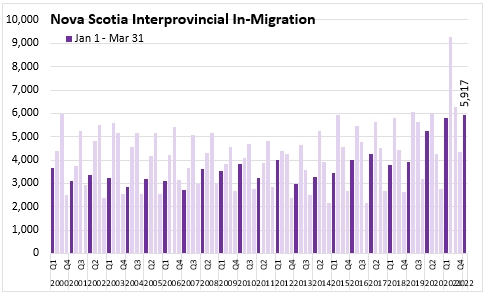
A total of 3,498 Nova Scotians left the province bound for other parts of Canada from January 1 to March 31. In the 12 months up to April 1, 2022 there were 14,159 out-migrants leaving Nova Scotia for other parts of Canada.
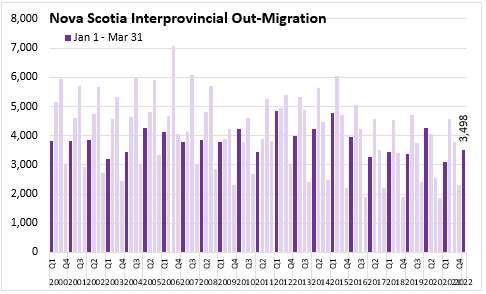
The net change in Nova Scotia's population from interprovincial migration was a gain of 2,419 from January 1 to March 31. From April 1 2021 to March 31 2022 there were 11,650 more in-migrants to Nova Scotia than out-migrants.
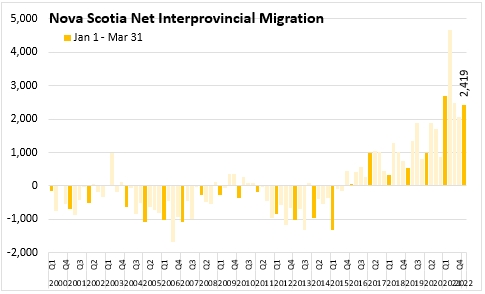
Out-migration from Nova Scotia to other provinces increased by 391 for January 1 to March 31 compared with the same period in 2021. Out-migration increased the most to Newfoundland and Labrador, New Brunswick and Ontario.
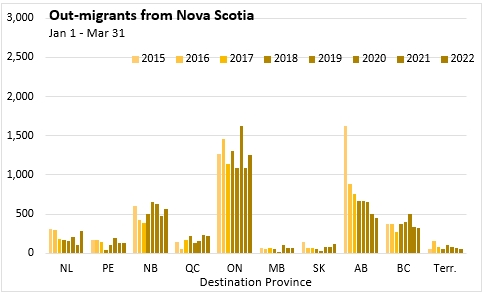
The number of in-migrants to Nova Scotia from January 1 to March 31 2022 increased by 111 from the same period in 2021. There were notable increases in in-migrants from New Brunswick, Prince Edward Island and Ontario. In-migrants were down from Manitoba, Alberta and British Columbia.
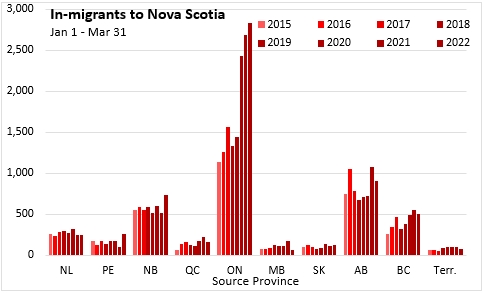
Comparing net interprovincial migration from January 1 to March 31 2022 with the same period last year, overall net migration declined by 280. There were increases in the flow of net migration from Prince Edward Island and New Brunswick, but decreases for all other jurisdictions. Ontario and Alberta remain the largest net sources of interprovincial migration for Nova Scotia.
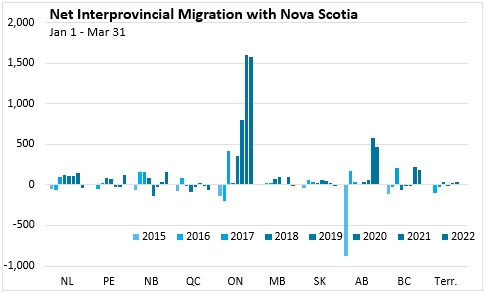
Source: Statistics Canada. Table 17-10-0009-01 Population estimates, quarterly; Table 17-10-0020-01 Estimates of the components of interprovincial migration, quarterly; Table 17-10-0040-01 Estimates of the components of international migration, quarterly; Table 17-10-0045-01 Estimates of interprovincial migrants by province or territory of origin and destination, quarterly; Table 17-10-0059-01 Estimates of the components of natural increase, quarterly
<--- Return to Archive